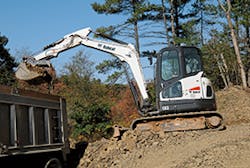As the economy steadily improves and more companies are rebuilding the financial resources to upgrade fleets with compact equipment, it’s more important than ever to have an understanding of emerging technologies. If you haven’t researched or purchased compact loaders and excavators before, you may be surprised at the level of innovation with new machines.
Despite the mature market position of compact equipment, manufacturers have recently introduced some of the most sweeping changes in decades. Advancements include more operator-friendly designs, higher performance levels, increased working capabilities, smarter data capacity and significantly better engine efficiencies than previous generations.
To make the best investment, owners and operators must grasp the compact equipment industry’s leading technologies and how these advancements translate into productivity gains.
Preferred Controls
Manufacturers know that when a compact loader operator uses a preferred control system and pattern, productivity typically increases and there’s less fatigue. For this reason many manufacturers offer different hydraulic control setups. Some of the available configurations to operate lift arms and buckets or other attachments, include foot pedals, hand controls, and joystick controls.
“Foot pedals and hand controls have been available on compact loaders for a long time. In recent years, joystick controls have gained popularity. Operators like the reduced effort, low fatigue, and adjustable settings that this type of system has to offer,” says Mike Fitzgerald, loader product specialist with Bobcat Co.
For jobs that involve multiple operators, many manufacturers’ joystick control patterns can alternate between ISO and H-Pattern to match a particular operator’s preference. This plays a key role in maximizing comfort, efficiency, and productivity. Virtually all of the control systems allow attachments like a planer, trencher, or tree spade to be activated with fingertip switches.
Some of these controls also have capabilities that provide adjustable response levels for operation in a variety of conditions. Machines that offer a built-in speed management feature allow operators to adjust their travel speed separately from the engine speed to achieve an optimal setting for the attachment they’re operating.
Additionally, for side-shifted attachments, machines equipped with steering drift compensation can maintain a desired travel path in forward and reverse directions alike. By adjusting the drive torque for either side of the machine, this feature enables operators to perform functions on uneven surfaces without constantly correcting their path.
Smart Instrumentation
According to Tom Connor, excavator product specialist with Bobcat Co., another major development in compact equipment has driven improvements to cab visibility, comfort and performance management with front-mount instrumentation panels. By locating instrumentation panels in front of the operator, where they’re easier to identify and reach, an operator’s line of site also aligns with the existing cab components and work group structures to maintain visibility to the attachment.
“Excavator and loader instrumentation technologies can also help owners and fleet managers better evaluate their performance and costs. These systems also assist them with identifying opportunities to improve machine and operator effi-ciencies and protect their investments,” says Connor.
Today’s instrumentation panels have been engineered with data management technologies that use LCD screens to display machine and operator data. Some instrumentation systems also incorporate the functionality to capture user statistics, vitals, diagnostics and individual fuel usage and real-time fuel consumption, as well as many other functions.
User performance monitoring covers fuel consumption and efficiency modes, attachment usage, idle time data, and multilanguage interfaces. Machine performance monitoring includes attachment-specific tips, diagnostic capabilities, machine access options (including keyless start), theft prevention, advanced engine emissions, and engine and hydraulic system maintenance intervals.
The most significant changes in compact equipment are the advances in engine exhaust after-treatment technologies as a result of federal emissions standards that have been implemented over the last few years. Most manufacturers have typically incorporated diesel oxidation catalysts (DOCs) and diesel particulate filters (DPFs) to remove these contaminants and achieve Tier 4 compliance.
However, the newest designs available are eliminating the need for a DPF. In addition, some new engines are providing an increase in torque that is produced over a wide range of engine rpm, allowing operators of all skill levels to better utilize the machines’ maximum performance.
Some new Tier 4 loaders and excavators also feature a machine protection system that monitors, manages and shuts down the engine if needed. This system monitors engine coolant and oil temperatures and will manage engine systems to reduce the potential of these fluids reaching a point where the machine has to be shut down.
Another new feature of some manufacturers’ compact loaders and excavators is cold weather protection. With this engine enhancement, anytime the engine temperature is too low, the loader or excavator will temporarily limit the maximum engine speed (rpm) to prevent premature component wear or failure. Engine idle speed is also raised slightly to help the engine reach its operating temperature faster. As soon as the engine warms up to a predetermined temperature, the protection mechanism will deactivate.
These are just some of the many exceptional developments in the ever-changing compact equipment market. Businesses that take time to identify and understand these new excavator and loader technologies can significantly improve the volume and quality of their work.



